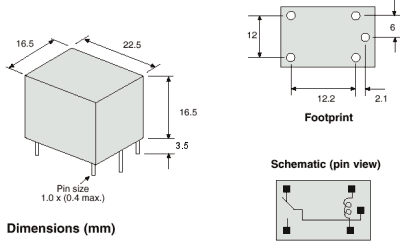Anglia Components
|
||||
|
||||
|
||||
OKO’s improved 'sugar cube' relay offers greater Power switching
 |
Despite the speed of technological developments, some products prove so popular that their key parameters and design features remain virtually unchanged for years. One such product is the ‘sugar cube’ relay, which has proved useful to many designers who needed to switch up to 10A, whilst using relatively little PCB area. |
Anglia, the broadline distributor, is the UK agent for OKO who have produced an up-rated relay, the K6, that has the same PCB layout and dimensions of the traditional ‘Sugar Cube’ style relay but is capable of switching 12A. John Nash, Anglia's Marketing Manager for relays, explains a little more:
“Many of our competitors produce a 10A relay, of this size, however we have always felt it was important for OKO and Anglia to better the competition. We can now offer a package that is compatible with our competitors pin arrangements, but is rated at a much better 12A. Due to OKO’s design expertise and production methods, costs have been kept as low as possible, which means the OKO K6 range is competitive with the 10A sugar cube relays on the market. This is a fantastic low profile miniature power relay that can switch 20% more than some of the leading manufacturer's products.”

The K6, which is just under an inch long (22.5mm), has long been used in heating and other control applications, as well as in the lighting and security markets, but is suitable anywhere that heavy loads of up to 12A need to be switched. Like all of the OKO range the K6 series is UL recognised and was rigorously tested prior to release onto the market at Anglia’s purpose built test facility in the U.K.
As standard the K6 has a low power consumption coil of 360mW and single pole changeover contacts. In line with OKO’s ethos of design choice, the K6 is available with a range of coil voltages from 3Vdc to 48Vdc and a choice of contact materials, which means there are 14 variants for designers to choose from. Due to the competitive nature of the K6, and its enhanced switching capability, the K6 is proving to be a very useful relay for designers who have a wide range of applications and would prefer to specify just one relay, thus reducing inventory costs.
Click here to download technical data on the K6 range in Adobe Acrobat .pdf format.
This article was originally published in February 2002
